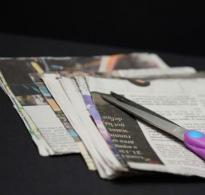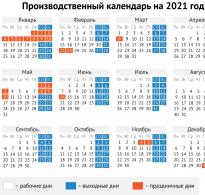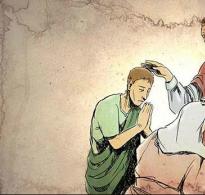How to sew a women's winter parka. How to sew a winter jacket. What to sew from
Difficulty level: average
Technical drawing of the model:
Description of appearance
Women's parka (jacket), interseasonal, casual, with a lined hood, with a central side zipper closure. Shelves with patch volume pockets with flaps fastened with a button and a windproof flap fastened with 6 buttons. Single-seam set-in sleeve. The waistline is emphasized by an adjustable band.
Structural additions to this model: to chest girth -14 cm up to size 52, 16 cm starting from size 54; to waist circumference 38-39 cm; to the hip circumference 12-14 cm. The length of the product is 17 cm above the knee line.
Materials: basic - raincoat (jacket) fabric: lining - lining material, including quilted with insulation.
Attention! If you decide to use insulated lining material, keep in mind that the design addition to this model suggests the possibility of using thin insulation with a surface density of no more than 100 g/sq.m.
When ordering a pattern you receive 3 pdf files:
- A file with instructions for printing a pattern, containing a control square and the measurements according to which the pattern was constructed;
- File with pattern in A4 format, for printing on a regular printer
- File with a pattern on one large sheet - for printing on a plotter

* PRINTING ON A4 FORMAT PRINTER:
When printing patterns in A4 format, open Adobe Reader and check the "Actual size" checkbox (or uncheck "Fit to page size") in the print settings.
Note the test square (or grid) on the pattern sheet. Its size is exactly 10 by 10 cm. It is needed in order to understand whether the printing scale is set correctly on your printer. Before printing the entire pattern, print out a sheet with a red square and measure it. 10cm sides? This means you can print the remaining pattern sheets. If the sides are more or less than 10 cm, you need to adjust the print scale of your printer. Otherwise, the pattern will not print correctly.
After printing all the pattern pages, glue them together in the order shown: the letters (A/B/C+) indicate the column, and the numbers (01/02/03+) indicate the row. The first (top left) pattern sheet will have the number A01.
*PRINTING ON A PLOTTER:
When printing a pattern on a plotter, open the pattern file in Adobe Reader (or Foxit Reader). Click on the "File" menu item, then select "Print". Select the Poster print mode under Page Sizing and Handling. Make sure the Segment Scale field is set to 100%. Check the boxes for Cutting Marks, Labels, and Split Large Pages Only.
The following designations are used on the pattern:
.png)
Parts Specification
Main material
- Shelf – 2 parts
- Back – 1 piece (with fold)
- Collar – 2 parts
- Sleeve – 2 parts
- Hood – 2 parts
- Hood insert – 1 piece
- Hood facing (main part) – 2 parts
- Back neck facing – 1 piece (with fold)
- Pocket – 2 parts
- Pocket flap – 4 parts
- Fastener valve – 2 parts
- Zipper valance – 1 piece
- Pocket side – 2 parts
- Hood trim (extension) – 1 piece
Lining material
- Shelf – 2 parts
- Back – 1 piece (with fold). Cut according to basic materials minus back neck facing
- Sleeve – 2 parts
- Hood – 2 parts. Cut according to the main material minus the hood facing.
- Hood insert – 1 piece. Cut according to the main materials minus the hood trim extension
Padding material
- Valve - 2 parts
- Pocket facing – 2 parts
- Padding material for the allowance for processing the lower cut of the product – 1 piece
- Padding material for the allowance for processing the cut of the bottom of the sleeves – 2 parts
- Reinforcement of the left shelf for buttons (TPM strip 5 cm wide, 50 cm long)

Attention! If you have enough basic material, then you can cut out 4 “Hood” parts and 2 “Hood Insert” parts, but do not cut out the hood facings. This will greatly simplify processing.
Attention! When cutting parts, it is necessary to add seam allowances: 1 cm for all cuts, except for the bottom cut of the front and back and the cut of the bottom of the sleeves. Along the lower edge of the front and back - 4 cm, along the bottom of the sleeves - 3 cm.
Exemplary consumption of the base material is 1.5 - 3.2 meters, depending on the size and height of the product, as well as the width of the material.
Attention! The pictures show options for the arrangement of parts on a canvas of different widths “In Bending” and different sizes. Please note that the parts highlighted in color are cut out one at a time.
Attention! If you decide to cut the hood lining from the main material, the consumption will increase by 30 cm.
Advice!Before you buy the material, if you don’t already have it, make several options for laying out the cut pieces on the floor for “different material widths”, and you will understand what width will be optimal for your size and height. By the way, it is at this moment that you can determine the length of the zipper.
.png)

To make a jacket you will also need:
- lining material. The approximate consumption of lining material will vary from 1.1 – 2.8 meters. Material consumption depends on your decision to cut out the hood from the main material or the lining, as well as on the size and height;
- hot-melt adhesive cushioning material – 50 cm;
- zipper braid 60 (70) cm long, depending on your height;
- braid (cord) – 2 m;
- cord ends;
- buttons – 8 pieces;
- sewing threads.
Technological sequence of processing


27. Sew the valance of the zipper braid along the stitching seam of the zipper braid, placing the valance on the front side of the shelf and aligning the cuts (Fig. 2, line 2).
28. Fasten the zipper. Sew the zipper to the right shelf along the edge of the side.
29. Stitch the neck facing to the hem along the shoulder edges. Press seam allowances.
30. Sew the hem and facing of the back neckline to the parka along the edge of the side and the bottom edge of the hood lining (Fig. 2, line 3).
31. Sew the sleeve parts along the lower edges.
32. Stitch the sleeves into the armholes.
33. Determine the length of the sleeves and iron the finishing allowances to the wrong side.
34. Determine the length of the parka and sweep the allowance for finishing the bottom to the wrong side.
35. Determine the location of the waist line fastener. Cut out a strip of any material with a width of 5 cm and a length equal to the width of the finished product minus 10 cm. Mark its location, insert eyelets for the cord or overcast the loops and stitch a strip of material under the cord, placing the cord under it along the marked line.
36. Hem the bottom edge of the parka on the front section with hems.
37. Prepare the lining of the parka (connect the front and back along the side and shoulder sections, sew the lining sleeves along the lower sections, sew the lining sleeves into the lining armhole). Attention! Leave a hole 15–20 cm long in the bottom seam of the left sleeve.
38. Sew the parka lining along the inner edges of the hems, the lower edge of the back neck facing and the lower edge of the product. Adjust the seam allowances for the hemming and facing.
39 Sew the sleeve lining to the sleeves along the bottom edge (Fig. 2, line 4)
40. Turn the product right side out through the hole in the left sleeve.
41. Attach the lining to the parka along the side and shoulder seams.
42. Stitch the hole in the bottom seam of the sleeve.
Option 1. The simplest option is a quilted lining with insulation. In this case, the details of the lining of the front, back, sleeves and hood completely repeat the details of the top MINUS the hem (on the front) and MINUS the facing of the back neckline on the back. The quilted lining with insulation is assembled in the same way as a regular (non-insulated) lining - with a “robe” and connected to the top.

Option 2. The insulation is cut out separately. In this case, the insulation parts also repeat the lining parts. Next, one of the most common methods of processing insulation and connecting it to the product is used. The lining parts are assembled with a “robe” and separately the insulation parts are assembled in the same way, with a “robe”. Then, along all sections of the insulation, a strip of material 2 cm wide is sewn with an overlay seam (along the edge of the side, bottom, neck) so that the strip extends 1 cm beyond the sections (see Fig. 4). This strip is used as an intermediate element between the upper parts and the insulation, i.e. Having prepared the insulation, it must be connected to the parts of the top along all sections, folding the top and the insulation of the back side with the back side and combining the sections of the intermediate element (strips) and the sections of the hem, the facing of the back neckline and the sections of the bottom of the sleeves. This way you will get a top connected to the insulation. Next, you connect the lining to the product to which the insulation is already connected.
I’ll say right away that I’m not a professional at all. I started sewing only 2 years ago while on maternity leave. And now I can’t imagine my life without it)) I especially love sewing outerwear. Mainly by studying in various master classes, which abound on the World Wide Web. I will try to describe all the stages as simply and clearly as possible.
Let's go.
It all starts with cutting. We place the parts on the fabric, chop and cut them out. This is a membrane top fabric, lining is French velboa fur, Alpolux 200 insulation, for temperatures up to -35 degrees. It is imperative to adhere to the grain line so that the product does not skew on the person.


All details are cut out. This is my handprint))

I marked the stitch lines on the lining so that the insulation and lining would not warp when worn, and it looks beautiful. I pinned all the lines together with insulation so that nothing would escape when sewing on the machine.


Once I had everything quilted, I trimmed off all the excess insulation around the edges and began sewing the pieces together and sewing on the facing. I sewed on a branded tag))


Now I start sewing pockets and sewing on the drawstring, insert a hat elastic there to adjust the waist, thread the elastic into the drawstring



The hood is completely ready. I sewed the lining with the top fabric, and threaded an elastic band to tighten the hood. I made double cuffs into the sleeves.


I sew the lining to the outer fabric. I sew on the wind flap, sew in the zipper, punch holes and insert buttons using a hand press.
Let's sew a parka jacket! Detailed pattern construction!The jacket costs the same as the base of the jacket, only the increase in freedom of fit is 16-20 cm. Today we will look at the construction of a parka jacket. It can be worn with or without a belt. Add additional darts or do without them.
Important: the initial data was taken as measurements of size 50 for women according to the Italian cutting system. 
For other sizes, see Standard measurements used in the Italian cutting system for women: 
Back detail
(1). We start constructing the back part from the upper left corner, placing t.A. From it we put down a segment equal to 1/24 Size + 0.5 cm, put T.V. From t.A we also put 4.5 cm down and put t.B1. From t.A down we set aside 1/8 Height + 1/24 Size + 2.5 cm (increase for loose fit), put t.C. From t.A down we set aside the DTS measurement, put t.D. and from t.A down we put the measurement of the Jacket Length, in our case 90-95 cm, set t.F. 
(2). From t.A to the right we set aside 1/6 of the Size + an increase of (1-2) cm – t.G. We connect points B and G with a smooth line - we get a back neckline. 
(3). From t.A to the right we set aside the measurement ½ ШС + increase (1-2) cm, put t.N. From point C to the right we set aside a segment equal to 1/24 OG + 5 cm, put point C1. From t.F to the right we set aside a segment equal to CC1, put t.F1. From t.H we draw a perpendicular downwards until it intersects with line CC1, place t.I. Connect points F1 and C1. 
(4). From t.N we lower 4.5 cm down, put t.L. From t.B1 to the right we set aside a segment equal to the measure of ½ ShP, put t.L1. From t.L1 up we put a perpendicular 2 cm, put t.L2. We connect it to t.G.
(5). We extend the line of the shoulder slope by an amount equal to the length of the sleeve (Druk), put t.I1. From t.C1 we put 2 cm down, put t.C2. From t.I1 we put 16 cm down, put t.L. We connect to point C2 with a straight line. 
(6). From t.L2 along the line downwards we put 6 cm and put t.L3. We connect it with t.C2 with a smooth line - we get the back armhole line. The contours of the resulting sleeve are red. 
Front detail
(7). Points A, C, D, F are constructed in the same way as in the drawing of the back part. 
(8). From t.D up, we put aside the measure of the accident, put t.A1. From t.C to the left we set aside a segment equal to ¼ OG + 5 cm, put t.C2. From t.F to the left we lay off a segment equal to CC2, put t.F2. Connect the resulting points. From t.C2 we put 2 cm down and put t.C4. 
(9). To the left of t.A1 we set aside a segment equal to 1/6 of the Size + an increase for a loose fit equal to the increase in the drawing of the back detail (1-2 cm), put t.G. From t.A1 downwards we put aside a measurement of 1/6 Size + 2.5 cm, put t.V. Connect the dots to get the front neckline. From t.A1 to the left we put aside a measure of ½ ШС - 1 cm, put t.N. From t.H we draw a perpendicular downwards until it intersects with line CC2, place t.I. 
(10). From t.N we lower 6.5 cm down, put t.L. From t.G we set aside a length equal to segment GL1 in the drawing of the back part, put t.L1, and points L and L1 are on the same horizontal line. Connect to T.G. From t. L1 upward we set aside 2 cm, put t. L2 and copy the sleeve pattern from the drawing of the back part to the drawing of the front part. 
Button placket for jacket fastening
(eleven). From point B to the right and left we set aside 3 cm, put points, draw perpendiculars down from them and extend the line F2F to the right by 3 cm. We get a placket for the jacket fastener with buttons. 
(12). To the left of t.G we put 5 cm and from t.F we put 10 cm to the left, connect the resulting points. 
(13). We unfold the sleeve and from point L3 we draw a perpendicular equal to 1 cm upward and draw a new line for the hem of the sleeve. The sleeve can be made with cuffs, without them, etc. what is enough imagination?
You will need
- - pattern;
- - scissors;
- - sewing machine;
- - threads and needles;
- - jacket fabric;
- - insulation;
- - lining;
- - strip of fur;
- - dense edging;
- - elastic cord with tips;
- - buttons and tongs (or press) for riveting them;
- - three detachable zippers.
Instructions
Choose a simple and practical pattern. You can use a ready-made pattern from a sewing manual as a basis, or use old clothes and open them along the inside seam. Carefully calculate the size, not forgetting about the loose fit - after all, you will be wearing the product over a thick sweater.
It is recommended to make the following cut details: - large: left and right shelves; back; a pair of shelf yokes; back yoke; left and right sleeves; hood (middle, sides and facing); - small (they can be cut out from leftover material): patch pockets; double stand-up collar; valves on the hood and sleeves; double zipper strip; a pair of facings on the sleeves and hems. Clothes from these parts can be made for children and adults of any gender; it is enough to adjust the length, color and, if necessary, make a drawstring at the waist.
Choose suitable materials for sewing a winter jacket. You will need facing and lining material. A piece of thick polyester is good as an outer fabric; for the lining (including the lower collar), you can take fleece fabric. Depending on the desired thickness of the codend, select the number of layers of sealant. It is good to decorate the hood with a trim made from a strip of natural or faux fur.
Cut out the details of the cut - the “face” of the jacket, lining and warm filling. Next, you need to apply one layer of insulation to each cut part and sew it with a regular horizontal stitch with long stitches. Attach other warm layers (from two to four) with a large mesh to the lining.
Sew the pockets to the front of the jacket. To do this, sew leaves onto the back of the burlap. For volume, a thin layer of insulation can be placed inside the drowning leaf. Sew both parts of the patch pocket to the front of the product; You can also put a thick piping along the seam - this will look more professional. Use it to treat the lower edge of the sleeves.
Complete the main connecting seams of the product and proceed to small but important details. To ensure that the jacket provides good protection from the wind, sew flaps on the hood and sleeves. Rivet metal buttons onto them. If you do not have a special punch press for rivets and eyelets, buy special pliers for installing such fasteners in the sewing accessories department.
Work carefully: make a hole in the jacket fabric with a smaller diameter than the button; Press the parts of the fittings accurately and try not to damage the front part. To do this, before squeezing the button, you can put a piece of thin rubber (for example, a plumbing gasket).
Sew a detachable zipper onto
The parka is truly universal clothing. It is suitable for both hiking enthusiasts and residents of large cities who are generally not inclined to travel. You can wear it with jeans, a skirt, and even an evening dress made of light, flowing fabric. Unfortunately, it is not always possible to choose an interesting style in ready-made clothing stores, and sewing in a studio is quite an expensive pleasure. Is there a way out? Of course have. Take a needle and try to do everything yourself. You will learn how to sew a parka with your own hands from the article.
What kind of park could there be?
To sew a women's parka with your own hands, you will need some materials. Look, maybe you have something in your closet - if not for the main parts, then at least for the additional ones. Now in fashion:
- patches on the elbows - leather and waxed fabric;
- leather pockets:
- knitted cuffs;
- fur trim on the sleeves and hood.
Important! And don’t be shy - it’s quite possible that you will come up with some details that clothing designers don’t even know about yet. But first, of course, you need to think about how to sew a parka without any additional decorations.
What to sew from?
The traditional material for parkas is canvas. It is best used for sewing; fortunately, there is no shortage of such fabrics now. The canvas has a sufficient width - as a rule, it is 150 cm. But, if there is nothing suitable in the store, you can use other materials:
- raincoat fabric;
- bologna;
- advice;
- tarpaulin.
Important! It should be taken into account, however, that the tarpaulin may be too heavy for a woman’s fragile shoulders, and besides, not every machine will take it. But the store almost always has raincoat fabric; it is easy to sew and practically does not fray. Bologna and avisent are good materials, but they must be sewn with synthetic threads; cotton threads will tear very quickly. The easiest way to cut an avisent is with a soldering iron or a burning machine.
How much material is needed?
The fabric is calculated depending on the size, but in any case, with a cut width of 150 cm, even the largest lady with curvy figures will need no more than 3.5 m.
Important! The standard flow rate is 3.3 m, this is enough for jackets of almost any women's size.

What else is needed?
To sew a parka yourself and not look like a scarecrow in the garden, you need some additional materials - they will make your jacket very similar to the branded one. You will need:
- interlining;
- detachable zipper (60-65 cm, depending on size);
- about 5 m of cord;
- Velcro tape 2 cm wide – approximately 10 m;
- twill tape 10 cm;
- punching blocks – 2;
- 4 half rings with a diameter of 1.5 cm;
- 2 rivets;
- sewing supplies;
It is always useful to have in your household such things as silk paper for patterns, scissors (tailor's and paper), pencils, tape measure, pins (tailor's), chalk, glue stick, carbon paper, sewing needles.
How to sew a parka - pattern
It is best to sew outerwear using ready-made patterns, especially if there are additional details like a hood and pockets. You can easily find a parka pattern in any branded fashion magazine - for example, in Burda. Moreover, drawings for such products are systematically posted on the websites of popular design firms, so all that remains is to choose the size. This won't be the case.
Important! Parka - the jacket is loose enough, and if you make a mistake by a couple of centimeters, nothing bad will happen.
- Tracing paper is applied to the pattern sheet.
- The parts are traced exactly to size - be sure to pay attention that all the patterns are from the same model; on the sheet of patterns from the magazine, all the lines are mixed up. But each product has its own designation; you will find it next to the image of the jacket.
- Be sure to apply all the markings - arrows, points where sleeves and hood are aligned, lines for sewing pockets and flaps.
- Some patterns give the outlines of bias tapes, straps and facings for certain parts - translate them too, this will save you a lot of problems.
Important! The outlines of additional parts on pattern sheets are not always printed; in this case, they should be drawn directly on the fabric.
How to lay out patterns?
Sewing is an expensive business, and you shouldn’t waste material. You need to lay out the patterns so that:
- they all fit;
- the direction of the thread was observed - the main fragments are cut along the lobar, some details - along the bias;
- There is room left for allowances and additional details.
Since the main parts are almost all paired, the fabric can be immediately folded in half, for example, along the grain thread. Your material is most likely monochromatic, so you won’t need to adjust the pattern. If you took a pattern from a company magazine, it is best to take the editor’s advice on how to distribute the parts on the cut in the most economical way. In total you should get:
- 2 shelves:
- 2 backs;
- 2 sleeves;
- 2 front parts of the hood;
- 2 sides of the hood;
- 2 back parts of the hood;
- 2 visor parts;
- 2 valves;
- 2 selections;
- 2 bottom facings for the front and back.
Of course, you need to cut on the wrong side, that is, the fabric should be folded with the right side inward. It is useful to pin the patterns, especially if you used rolled tracing paper, which tends to curl up. After all the parts are laid out and outlined, mark the allowances - it’s convenient to do this using a ruler. The width of the seam allowance is 1.5 cm.
What else needs to be cut out?
If there were no small details on the pattern sheet, they should be drawn directly on the fabric. You should now have:
- 2 facings for pockets - their size is 22x4 cm, but may differ in one direction or another;
- neck facing (cut on the bias);
- top drawstring (a strip approximately 110 cm long and 6 cm wide, but the size may be slightly larger or slightly smaller, depending on the size);
- cuffs - 2 rectangles 4 cm wide and about 40 cm long (plus or minus 1 cm, depending on the size);
- 2 long straps (9 cm long);
- 2 short straps (7 cm each), the width of both is 3 cm.
We cut the interlining
Some parts need to be covered with non-woven material so that they keep their shape. The following parts are reinforced with non-woven fabric:
- selection;
- cuffs;
- pocket flaps:
- straps.
Place the corresponding parts (paper patterns or finished fragments) on the non-woven fabric and trace, and then cut out, not forgetting the allowances:
- Place the parts with the wrong side on the adhesive part of the interlining.
- Align all the cuts.
- Iron the gasket.
Let's start with the little things
They say that the devil is in the details, and this fully applies to sewing outerwear. The ease of assembly, and ultimately the appearance of your jacket, depends on the quality of processing of small elements.
Before sewing a women's parka with your own hands, prepare the details:
- Take paired parts with and without interlining - for example, valves.
- Place them right sides together, carefully lining up all the edges.
- Sew along the contour, leaving open only the cut that will be stitched to the shelf.
- Turn it inside out.
- Iron.
- Make a finishing stitch at a distance of 0.5 cm from the seam.
- Iron the open seam allowance to the wrong side.
- Sew the flaps to the shelves strictly along the stitching lines - it is very convenient to use Velcro tape for such purposes; the flap is simply first glued with a glue stick, and then sewn on. But, if there is no tape, you can simply sweep it.

Stitching pocket facings
Fold the pocket facing in half lengthwise with the right side facing out. Iron the fold. We mark the alignment line at a distance of 1 cm from the line along which the facing will be sewn:
- Align the facing with the intended stitching line - the open edges should be on the marking.
- Sew the piece.
- Turn the seam allowance over, baste or pin.
- Baste and sew the flap.
Processing the slots
On the shelf you have a line for sewing the pocket. Cut through it to leave 1 cm to the end of the facing. This must be done very carefully so as not to cut through what should remain intact. Turn the pocket facing towards the cut, and the flap - the opposite way.
- Sew the burlap - start with a smaller piece.
- Baste it right side to right side.
- Sew it on.
- Sew seam allowances together.
- Sew the larger piece in the same way.
- Sew both parts of the burlap together.
Collecting the main details
Pockets are a delicate matter, and if they are ready, then you can move on to the next steps. The hood also needs to be processed carefully, but first it’s better to put everything together. The order at this stage will be traditional:
- Baste the edges to the shelves, inserting the free ends of the detachable zipper into the seam - to do this, the parts need to be folded with their right sides facing each other, pinned together and stitched.
- Turn the hem to the wrong side and iron.
- Make a second selection.
- Baste and stitch the shoulder and side seams.
- When sewing in a sleeve, pay special attention to the alignment points - they must coincide on the collar and armhole.
Hood
First, let’s baste and sew all the details:
- To the front part we sew a facing - a strip cut on the bias.
- We drive 2 rings at the bottom.
- When the hood is ready, align its lower part with the edge of the neckline - and don’t forget about the dots! We sew, iron the allowances to the side of the jacket and overcast them together.
Sleeves
Cuffs are made for the bottom of the sleeves; you have already cut them out:
- Fold the cuff in half lengthwise, right side inward.
- Sew along the edge, leaving the stitching line open.
- We put the allowance along the stitching line inside and iron it.
- We baste the piece by placing the sleeve cut between the cuff allowances.
- We attach it.
- We try on and punch the buttons.
- Sew short tabs along the top of the cuffs.
Important! The bottom of the sleeve can also be made with an elastic band - then a cuff is not needed, and the cut just needs to be hemmed by 1.5-2 cm.
Making a clasp
Basically, the jacket is ready if it has a zipper. But you can do it differently - for example, make a Velcro fastener or do as the old tourists did - sew on stylish large buttons. But then you will need to immediately process the slotted loops. However, the classic parka is still fastened with a zipper, and a detachable one.
Let's bring it to mind
There are only a few steps left:
- sewing a waist drawstring to the wrong side is simply a strip in which long sections are folded and ironed to the wrong side, after which the part is sewn along the waist line;
- process the bottom - you can hem it;
- sew the tabs on the places allocated for them;
- insert the cord into the waist drawstring and the front of the hood.
Jacket options
This was a description of the simplest parka. But other options are also possible - for example, with a permanent or detachable lining. They will be somewhat more complicated, but if you find, for example, not very thick faux fur. Everything can be done very quickly.
What can you make from a parka?
There are also directly opposite options. You have an old parka that for some reason you no longer wear, but it’s a shame to throw it away - what can you do with it?
The easiest option is to sew a jacket for a child. In this case, you need to follow one simple rule - from each part a similar one is cut, and elements that require special care are best used completely. These are valves, straps and the like.
Video material
In a word, sewing a parka is not so impossible. The most important thing is to dare and pay special attention to small details, because the signature look of outerwear largely depends on them.






